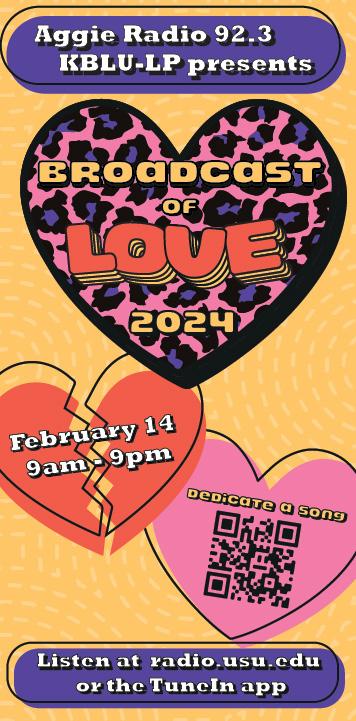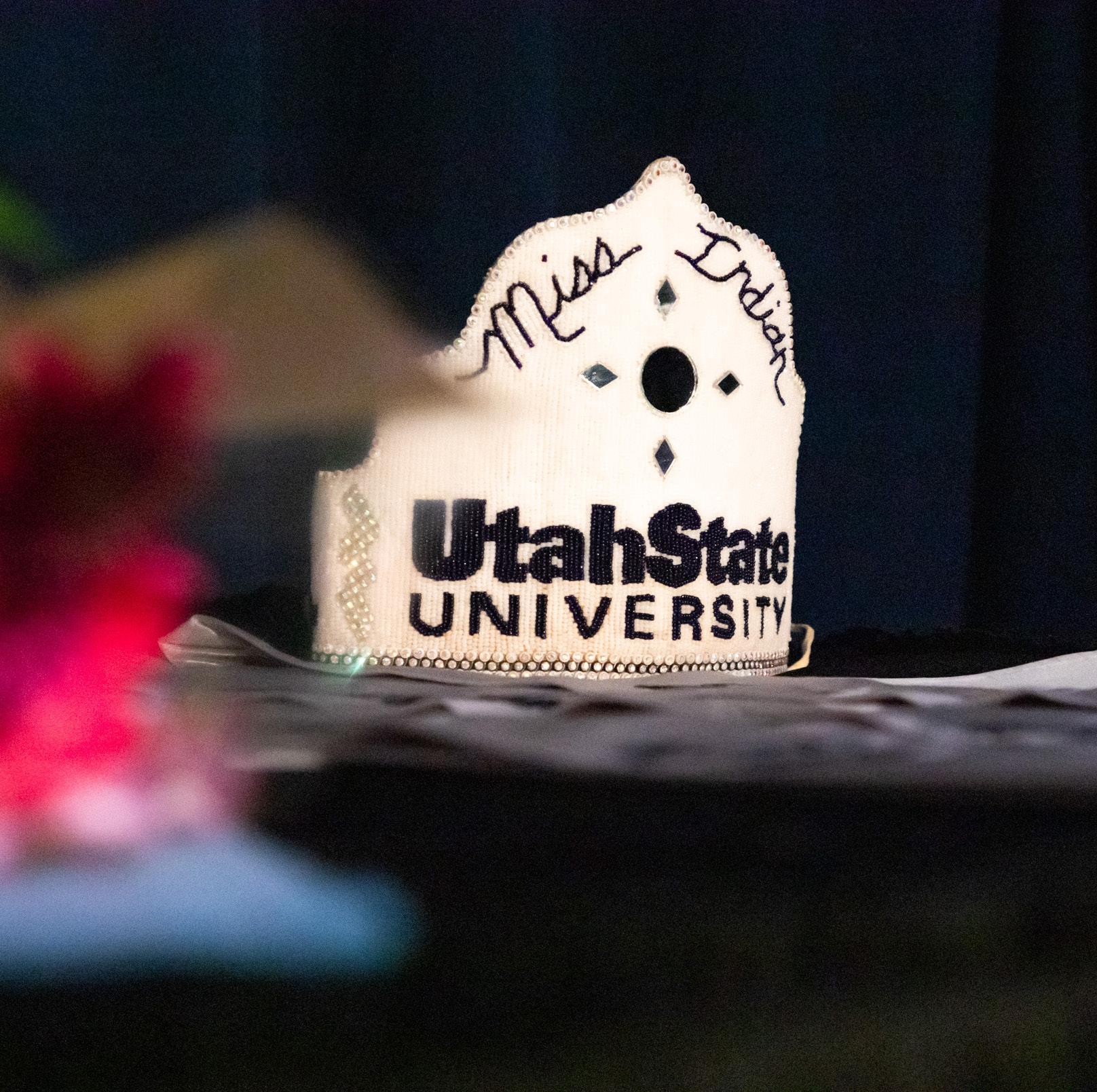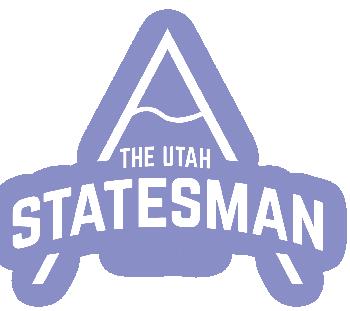
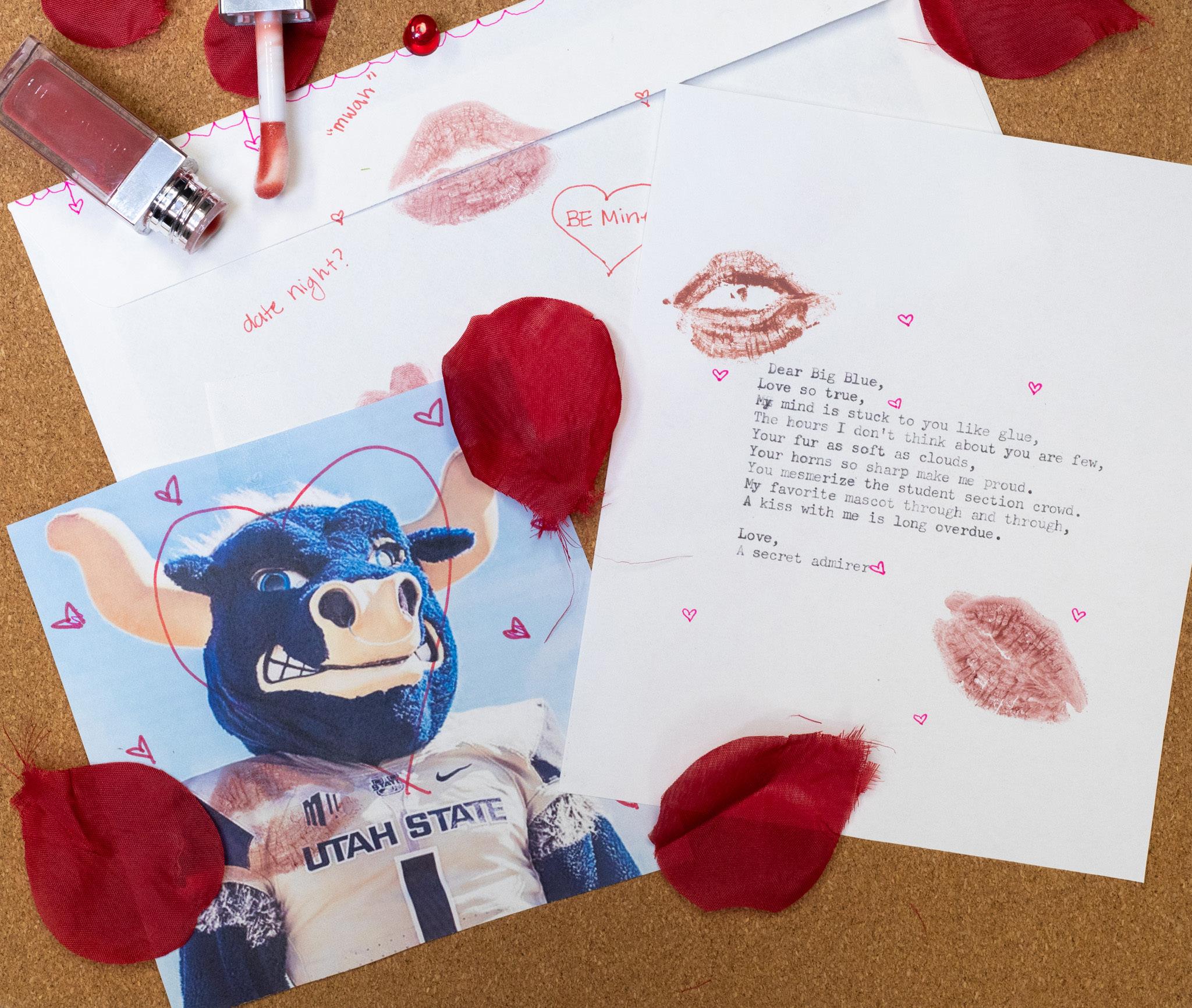



By Jack Johnson NEWS REPORTER
Outside the Russell/Wanlass Performance Hall on Monday afternoon, protesters holding signs gathered under the hanging roof of the building to stay out of the rain.
Inside, the President’s Forum on Conflict and Conflict Resolution, hosted by Utah State University President Elizabeth Cantwell, was featuring a discussion between Gov. Spencer Cox and visiting professor and author Irshad Manji.
The peaceful protest was held in response to two bills recently signed by Cox after they passed the Utah House and Senate: HB261, “Equal Opportunities Initiative,” and HB257, “Sex-Based Designation For Privacy, Anti-Bullying, and Women’s Opportunities.” Both have been controversial in Utah politics.
“Maintaining the peace,” protester Clara Durling said. “We don’t want to disrupt anything. That’s been a very clear part of our planning is not to disrupt the speech.”
The overall sentiment was of unity and community. “We really want this to be peaceful and silent that we’re also here in consolidation with the community,” protest organizer Kris Carpenter said.
HB257, nicknamed the Bathroom Bill, states that males and females must use corresponding sex-designated restrooms, with the exception that people who do not identify as either may request special accommodations based on gender identity.
Durling said they plan on taking testosterone in the
future to transition into a male. Right now, they use the women’s restroom because they look more feminine.
“So, it’s not just simple to go into one restroom,” they said.
Protesters were mostly silent throughout the event. Many had the same sentiment surrounding the bills, stating they cannot legally use a restroom on campus anymore.
“We just want our voices to be heard about the recent bills that he signed,” said protest leader Samson Calderondiltz. “I basically cannot comfortably use a bathroom legally on campus.”
The bill states students in a public school setting may ask for accommodations on the basis of gender identity. The school then must provide a single-occupant bathroom, unisex bathroom, reasonable access to a faculty or staff restroom, or a staggered schedule that provides temporary access.
“I think that the bathroom bill specifically is going to make it really uncomfortable and anxiety-inducing for a lot of students who just want to use the bathroom,” said protester Bethany Haskell.
Protester Alex Blanche said they attended to show Cox who is impacted by the bills.
“We also just want to make our voices heard,” Blanche said.
Blanche said the definitions used in the bill are specific.
“You need a birth certificate and bottom surgery to be able to use any gendered facilities including bathrooms, locker rooms, showers,” they said.


The bill does require these qualifications — an unamended birth certificate or documentation of a medical procedure — to be met before a person can use a sex-designated restroom.
Carpenter said the bill “requires each new building to have a unisex restroom.”
Along with this, the bill says existing government buildings must renovate to provide a unisex bathroom.


Jack Johnson is not named after a singer, but a buttermilker. Everyone knows his name, but he rarely knows theirs.
— jack.johnson@usu.edu
By Malory Rau NEWS REPORTER
Throughout February, the Center for Anticipatory Intelligence, or CAI, at Utah State University is accepting priority applications to be part of the program. Located in Old Main, students accepted into the CAI program will collaborate with students of a different caliber to form well-rounded problem-solving skills.
Founded by Jeannie Johnson, former member of the CIA Matt Berrett, and Briana Bowen with the support of Dean Joe Ward of the College of Humanities and Social Sciences, CAI has been slowly growing over the last six years.
As the only program of its kind in the nation, CAI is leading the change in how universities teach about security. Anticipatory intelligence aims to predict threats and opportunities, reduce uncertainty and prepare for the future. This is most often on a national or global level. Students often look at humanitarian issues such as pandemics, global warming and national cyber security.
“I don’t know if it will make you smile or wince to know that three months before the pandemic hit, one of our students completed a paper on a zoonotic novel virus creating a worldwide pandemic,” Johnson said in her TEDxUSU speech. “His classmate completed a paper looking at our medical supply system and the choke points that would prove problematic in a regional or global crisis—these students were celebrated as prophets in their own time.”
The CAI program is open to all juniors, seniors, grad students, master’s, or Ph.D. students. Students can minor, receive a grad certificate, or master’s, also called MAI, in anticipatory intelligence. Each year, they only take about 55 incoming students. This provides not only a wide range of majors within the program, but also a wide age range allowing for a multi-generational collaboration.
“Having a community of people of every age, who are not going to give up, and who want to be problem solvers, they want to chip away at these problems or come up with creative solutions or move forward instead of apathy. That is at the heart of what we are doing, and what we have found,” Johnson said. “There are lots of things that are important to me, but one of the things that is most impressive and a favorite part is the community that has emerged out of it because these students love each other.”
CAI seeks to put students who come from all eight USU colleges into one classroom to provide a diverse range of problem-solving skills.
“We’ll have the biology students sitting next to the folklore student sitting next to the aerospace engineer. Then we give them this problem and they bring their really interesting, diverse perspectives to the problem,” Johnson said.
Current CAI student and political science major Scott Wilbur noted the CAI program is completely applicable to the 21st century, or as Johnson called it next-gen intelligence.
“Because it’s next-gen intelligence, then there aren’t a lot of methods, like a set way of doing things whether those are analytical tools or approaches. Those hadn’t been developed yet by the intelligence community. So USU is a lab school for anticipatory intelligence; we are the ones coming up with these new methods and testing them out and making sure they’re roadworthy.” Johnson said.
As a student of the program, Wilbur shared why he enjoys the

SUBMITTED PHOTO
CAI cohorts collaborate during class in Old Main.
program and what opportunities he has as a CAI student, specifically in the classroom.
“I think that it’s a place where anyone can bring something to the table. I appreciate that everybody has their own moment to shine. And to me, it seems like there’s always something one can contribute,” Wilbur said. “Everybody goes into classes that they want more experience in. So for me, I’m in Russian and Ukrainian perspective class, as well as a strategic culture class.“
As students leave the program and enter the job field, they can put skillsets from the program on their resume. Students will walk away from the program with not only multi-dimensional problem-solving skills but also an understanding of speaking, writing and different methods of analysis.
“Students emerge from this program with just a lot of confidence, because they have confronted so many different circumstances and had themselves tested in a lot of different circumstances, and because our grading standards are rigorous; by the time they emerge, they know they’re going to be good at this job,” Johnson said.
For students looking to apply, they will need to submit a resume and cover letter. They can do so at usu.edu/cai. They can also contact program coordinator Tyler Doering for further information.

Malory Rau is a sophomore studying social media, public relations and marketing. When not skateboarding with friends, she is usually thrifting, reading or seeing the latest movie.
— m.rau@usu.edu

By Sydney Lyman NEWS REPORTER
Last Thursday, three women at Utah State University competed for the prestigious title of Miss Native American. Emily Kimbrough, a student majoring in elementary education, walked away with the crown and the title of head woman.
The pageant, created and hosted by the Proposed Native American Cultural Center, was an annual event prior to the pandemic. This year was the first year the event happened since the pandemic.
Danny Piper, the faculty advocate for the Mentoring and Encouraging Academic Success Program, said the pageant creates a sense of community and helps educate non-Native students about Native American culture.
“You know, just trying to bring it back essentially kind of creates a sense of community for the students on campus,” Piper said. “It also educates others about Native American students on campus and just connects students to our community.”
The pageant serves multiple purposes, such as being a scholarship program. The winner also becomes the head woman of the 47th annual Equity and Traditional Ways Powwow and represents USU at three other powwows. The winner must complete 25 required service hours in the community. She leads the Native American Student Council in the homecoming parade and is also in charge of helping to plan the next Miss Native American Pageant.
The head woman’s role is one of prestige and honor. She leads the procession into the powwow and brings gifts to the head staff. Stacie Denetsosie, the Native American Student Council adviser, says the powwow taking place on April 6 is one of the main reasons the pageant takes place.
“A big part of why we even have the pageant is because of that powwow. It’s really important we have her, or else we have to find someone in the community,” Denetsosie said. “It’s really nice that we can look within our own students and find a Miss Native American.”
The NACC’s website provides additional information about the powwow.
“Traditionally, Pow Wow’s served a number of func-

tions. They were held in the spring to celebrate the new beginning of life. Honoring warriors, personal achievements, and ceremonies for dropped eagle feathers are still part of Pow Wows today,” the site reads. “The PowWow preserves a deep, lasting sense of family, pride and tradition. Behind the display of dance, music and vibrant regalia are sacred legends and meanings.”
Denetsosie acknowledges the role is demanding, but it provides incredible opportunities to Miss Native American and her first and second attendants.
“She has a pretty hefty role. The reason the role was developed was that it’s a scholarship program, so Miss Native American and her two attendants get a scholarship,” Denetsosie said. “It’s to promote their leadership in the community, and it’s a good opportunity for our students to represent USU.”
Emily Kimbrough, this year’s winner, said she loved the experience of competing alongside her friends, who are all officers of the Native American Student Council.
“It was nice to participate alongside my friends. It was
a great bonding experience as well. I am also grateful to express myself as an individual and as a Dine Asdzaan,” Kimbrough said. “It was truly rewarding. Love my girlies.”
Kimbrough competed alongside Maylene Livingston, first attendant, and Ashley Betony, second attendant. Those interested in volunteering at the powwow on April 6 or becoming a part of the Native American Student Council can go to the website usu.edu/nacc/.

Sydney is a junior studying political science, journalism and anticipatory intelligence. When she’s not chasing the latest scoop, you can find Sydney delivering puns so bad, they’re good.
— sydney.lyman@usu.edu

UTAH STATE
1/24/24
- An individual visited the Public Safety office requesting assistance with a Fix-It Ticket violation they had received. An officer verified that the indicated violation had been repaired.
1/26/24
-An intrusion was alarm reported to dispatch. Officers found no signs of forced entry or suspicious activity.
1/29/24
- A suspicious person was reported near the Animal Science Bldg. An officer observed an individual with a skateboard and instructed them on proper usage on USU property.
1/30/24
- Items that appeared to be a controlled substance accompanied with paraphernalia were reported. Officers investigated and determined them to be a controlled substance which violates USU policies.
1/31/24
- A purple and black mountain bike with no other was reported missing. Please contact USUPD if you have any information on this incident.
2/3/24
- An officer responded to a noise complaint. Upon arrival the officer spoke with individuals determined to have been the source of the noise, who agreed to keep the noise down.
- Officers observed suspicious behavior between members of a group. Upon further investigation officers found alcohol and issued citations to the responsible parties.

By Sydney Lyman NEWS REPORTER
Aeden Anbesse was a mentor, role model and friend to many students on campus. Her passion for her work as the Black & African American student program coordinator at Utah State University enriched the lives of countless people. Anbesse passed away on Dec. 29, 2023.
“ She was the first inaugural Black & African American student program coordinator of Utah State University’s Inclusion Center,” an obituary posted on Nelson Funeral Home’s website reads. “She used her platform to advocate for students who navigated intersectional barriers facing our community in academia.”
Jona Oduli, the Asian American and Pacific Islander Student Support Program Coordinator for Utah State University’s Inclusion Center, wrote to the Utah Statesman about her experience working with Anbesse. “As Aeden’s colleague, she impacted my life tremendously both as a professional and as a friend. She was the Asian Student Association’s advisor before I came into my role and so when I started, I relied on her prior experience with the club to help shape the vision I had for my program and what my advising “style” would be,” Oduli wrote in an email to the Utah Statesman. Oduli wrote being a program coordinator is a position of professional mentorship and Anbesse fulfilled this older sibling-like role with grace and excellence.
“As program coordinators our jobs can sometimes feel like we’re professional older siblings; we have our cultural connections that bind us, and though we don’t have enough authority to parent, we have just enough to guide the younger ones to the next step,” Oduli wrote. “So, I know that she cared for her students the way a big sister would, to the best of her ability.”
Oduli also wrote Anbesse contributed to diversity, equity and inclusion efforts on campus by being herself.
“After she passed, her family let us know that her work had been her respite, that this became the place where her dignity was preserved, where she could be a normal person. From the many conversations we had had about diversity issues and our lives as BIPOC folks, it was clear that the principle of normalcy was extremely important to her because it was never just easily handed to her as a Black disabled woman,” Oduli wrote.
Oduli wrote Anbesse’s treatment of her students exemplified the mission and purpose of the Inclusion Center. Anbesse treated everyone who she encountered as an equal.
“Excellence is something I don’t want to minimize, but it honestly has nothing on knowing with your whole heart that you don’t have to spend every moment of life working to justify your existence in order to be deserving of respect and dignity,” Oduli wrote. “Aeden didn’t care about who was considered excellent, average, or mediocre—to her, everyone belongs, which is a principle at the core of what we do in the Inclusion Center.”

The feeling of profound loss experienced by those who knew her serves as evidence of her incredible impact on the world, Oduli wrote.
“I think the immense grief I’ve felt from her passing really speaks to how she was so easy to love and admire—an instant true friend. I recently learned from one of her family members that when I started working in the Inclusion Center, she wanted to be work besties but didn’t want to scare me off,” Oduli wrote. “I get teary-eyed just thinking about it because I wish so badly that we could have had more time for our friendship to grow even more. There are so many things I had yet to talk to her about. I’m so grateful I got to be a part of her normal. Even though our time together was short, I know I’ll cherish our friendship for years to come.”
Ta’Mariah Jenkins, the secretary of the Black Student Union, shared her fond memories of working with Anbesse in an email to the Statesman and the advice Anbesse shared with minority students about attending a predominantly white institution.
“She kept all of our administration work organized and gave us some key advice that shaped our BSU to have some of our most successful events,” Jenkins wrote. “She was like a strong-headed anchor that held us steady. In addition to making sure we had solid advice in life and how to navigate being at a PWI school.”
Jenkins wrote she experienced firsthand the care and love Anbesse had for her students.
“She was a person that was diligent in me as a person and as a student,” Jenkins wrote. “She was firm about making sure my grades were on good terms before participating in BSU activities and wanted to make sure my mental health was stable.”
Beyond her work at the Black Student Union, Anbesse was described both in her obituary and by Oduli as loving beautiful things. Her obituary described her as a “bona fide maximalist.” Oduli described her as having a great taste and an eye for opulent aesthetics, influenced by her stint with Job’s Daughters when she was a child.
Anbesse was profoundly creative, and her obituary describes her hobbies of baking and ceramics. More so, as her obituary shares that Anbesse was vibrant, lighting the lives of those who knew her. She will be sorely missed.
“From an early start, she proved to be a force to be reckoned with and held the attention of all who knew her,” her obituary reads.

By Reagan Thomas NEWS REPORTER
Utah State University will be the first school in Utah to offer a four-year cybersecurity engineering degree, according to Jacob Gunther, the head of the Electrical and Computer Engineering Department.
The goal is for the program to begin this fall. The degree is awaiting final approval by USU, but the Utah System of Higher Education, or USHE, supports it. The College of Engineering is in the process of hiring two professors with expertise in the cybersecurity field, Gunther said.
“We’ve had a desire to have a cybersecurity program here in the Electrical and Computer Engineering Department for a long time,” Gunther said. P rogram development has been in the works for years, but only came about after the Utah Legislature allocated funds towards computer science in 2023. That is when the College of Engineering took a chance and submitted their proposed degree to the state.
“An area of computer science is cybersecurity,” Gunther said. “We applied to that and were rewarded.”
Cybersecurity engineering is a new and somewhat uncommon major — so far, there are only three accredited programs across the country.
Jacob Adams, a computer engineering major, said it seems like security is something missing from the current curriculum.
“We don’t really talk about security in any of our required classes,” he wrote in a text message. “I’m sure it will be a great addition to USU.”
According to Indeed, cybersecurity engineers design, develop and implement highly secure network solutions that prevent cyberattacks and hacking threats. Cybersecurity professionals are invaluable to businesses as data is increasingly vulnerable to expensive attacks. The International Business
Machines Corporation found in a study of 500 organizations that data breaches cost $4.24 million per incident on average.
Cybersecurity is a growing field, and it will grow even more so in the next decade. From 2022 to 2023, the U.S. Bureau of Labor Statistics estimates job openings for information security analysts will grow by 33%.
Gunther said this will be a draw for high school students considering college majors.
“I think students will be coming out of the woodworks to join this major,” Gunther said.
GRAPHIC BY Brenna Hiltbrand
In the past, Gunther said, engineers have built systems that can be hacked and imitated.
Not only are communications, navigations systems and personal data susceptible to attack, but everyday infrastructure can be vulnerable.
“We like to build things that help people. It’s just unfortunate that we’ve built a lot of systems without thinking very much about security. So rather than helping people, we’ve left people exposed to attack.” Gunther said. “We just need to be thinking about the future and safety and systems that we can trust and that are reliable.”
Gunther said this is why teaching these skills is important. “We are going to work really hard to prepare students to take on current and future challenges,” he said.
If students are interested in this program, they should switch their major to computer engineering, as it will have similar introductory classes.
“I would just speak on behalf of my department that we very much appreciate the support of our university administration. We surely appreciate the support of USHE,” Gunther said.

Reagan Thomas is an avid news junkie studying journalism and political science. When not perusing the latest stories of the day, she enjoys running, hiking, and stargazing.
— reagan.thomas@usu.edu



Ray Honahni. The show has a new theme each week, such as songs that bring them out of seasonal depression and songs that remind them of fictional characters. You can catch The Racket Monday’s at 3 p.m. on Aggie Radio
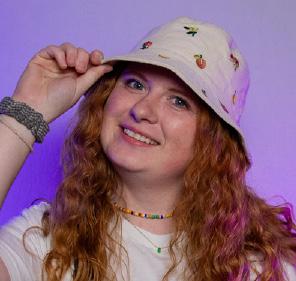



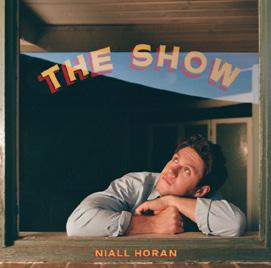
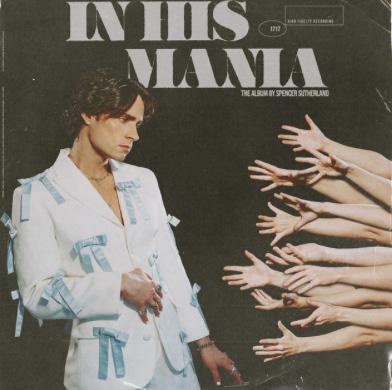





By Ella Stott LIFESTYLES REPORTER
Utah State University is saying goodbye to the annual Mardi Gras party, and saying hello to the first annual Casino Night.
USU Activities Committee has instigated a rebrand of the tradition, renaming it Casino Night to highlight the most recognizable piece of the event.
Jamie Parry, a senior in political science, is the activities committee director.
According to Parry, the name was changed because the event didn’t coincide with Mardi Gras.
Mardi Gras, translated from French to Fat Tuesday, started as a celebration before the Christian Lent. During Lent, many Christians prepare spiritually before Easter via fasting, repentance and other forms of spiritual discipline. In the past, many of USU’s Mardi Gras parties have been in January, a month before the actual celebration, and they didn’t include many aspects of the tradition as seen in places like New Orleans.
“We were doing really nothing to celebrate actual Mardi Gras except for usually using purple, green and gold and handing out beads at the very beginning,” Parry said.
According to Parry, this realization made her decide to look for a different name for the spring semester’s version of the Howl.
“It made more sense to broaden the scope of what this event can be,” Parry said. “We wanted to make it a little bit more dynamic like the Howl is and also describe what it actually is, which is a casino night.”
Josie Packer, a sophomore studying plant science, is a member of the activities committee.
According to Packer, it was important to the activities committee to bring something new and fresh to USU.
“It has just been Mardi Gras, and there isn’t a lot of variability with that,” Packer said. “With Casino Night, I feel like it can change a lot. It’s so encompassing.”
With Casino Night settled as the new spring semester

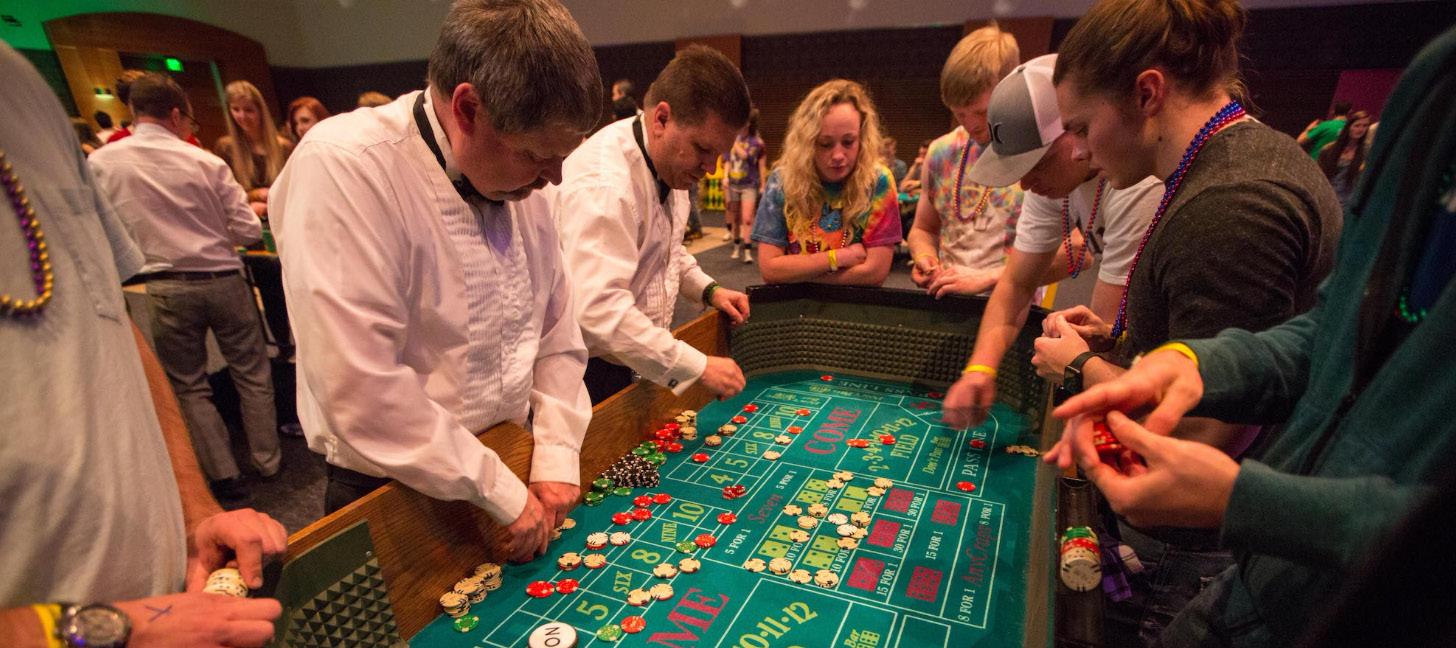
event name, the activities committee was faced with the challenge of deciding on this year’s theme.
“When we talked about it, we were like, ‘What are some things that remind you of a casino?’” Parry said. “What we landed on was doing something Vegas themed, because you immediately think of a casino when you think of Vegas.”
According to Packer, once the team had their Vegas theme settled, there were a lot of opposing ideas for the name.
“We got a lot of bad ideas,” Packer said. “But I think bad ideas are good because they just help us to be more creative.”
Parry said one of the favorite ideas was Cash Valley, but the idea never came to fruition because they couldn’t imply they were going to use real cash. Eventually, after lots of brainstorming, they landed on Viva Las Logan for the first annual Casino Night.
Along with the name change, several elements of Casino Night have differed from past Mardi Gras activities. For starters, this year, in addition to the TSC, portions of the event were located in the more spacious Fieldhouse.
“You can have it catered from outside places in the Field House, which is an advantage of having it there,” Parry said. One of the caterers of the night will be Raising Cane’s.
According to Packer, having the casino tables in the International Lounge of the TSC in past years made for a crowded environment.
“It just ended up being kind of chaotic and didn’t run as smoothly as we would have liked,” Packer said. “This year, with it being in the Fieldhouse, gave us so much more space to work with.”
Parry said the increase in casino tables was 30%, giving
more emphasis on the event’s new name. Games included will be blackjack, roulette and hold ‘em.
In addition to more space, new activities were added to Casino Night, including low stakes bingo and an Elvis and Taylor Swift impersonator.
There was even an addition of a marriage booth in the TSC sky room. The team got wedding dresses from a thrift store and cut out the backs so participants could get dressed up for their fake weddings.
According to Packer, the wedding idea started as a joke.
“I was just thinking like Little White Chapel,” Packer said. “And we’re like, ‘Wait, this is actually a great idea.’” Packer said the work the activities committee does to set up these events is rewarding because they get to see the impact of their hard work.
“At the end of the day, you’re cleaning up and it’s 2:30 in the morning and you’re like, ‘We totally just did that,’” Packer said. “We did that, and it’s because we get to work together.”
Parry said going to activities was one of the highlights of her first year, and Mardi Gras was her favorite event.
“When I joined the activities committee last year, it really did change my life,” Parry said. “Being able to not only create those lifetime memories for other USU students but work with a committee full of people that are just as passionate about that as you is super special.”

Ella Stott is a first-year student studying English and journalism. When she’s not writing, she’s watching sitcoms, eating Greek yogurt and admiring Nebraska corn.
Q: What is the main message or theme?
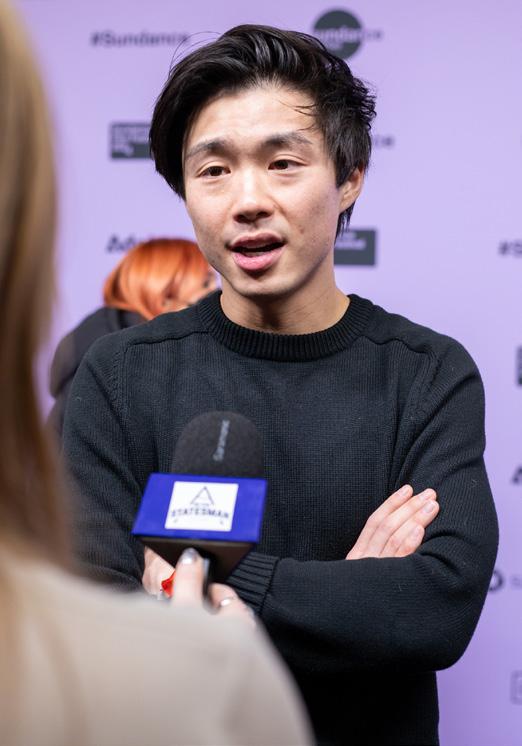
DIDI director Sean Wang
A: “I hope they feel stuff. The age 13 is so loud and crass and vulnerable and emotional and irreverent and sad and lonely. It’s all the things, it’s this time where your emotions and your body is just like exploding, but it’s also quiet and emotional. And so that was our hope with this movie was to hopefully have a movie that can have all of those emotions. I hope that audiences feel all of that while watching it and that’s all I can hope for. You know, I hope that people you know, I said it earlier, but I really feel like I got to make the movie I wanted to make. So I’m just excited for audiences to now get to see it.”
Girls Will Be Girls director Shuchi Talati
A: “It’s a really gentle heartwrenching coming of age story. It’s something very relatable to all of us. But it’s not what we often see portrayed in Indian cinema. As she has said many times before, any woman having any expression of sexuality is often punished by the storytelling and the audience also, because the storytelling guide and storytelling guides them to go that way. Then to feel a sense of shame — which is ironic because we are the most populous country in the world. So it’s happening. So I just, I feel like if we destigmatize sex and the shame around it, it would really benefit us as a society and really take care of our women a lot better and are meant to.”

Q: Did you discover anything about yourself while writing this film?
A Real Pain screenwriter and director Jesse Eisenberg
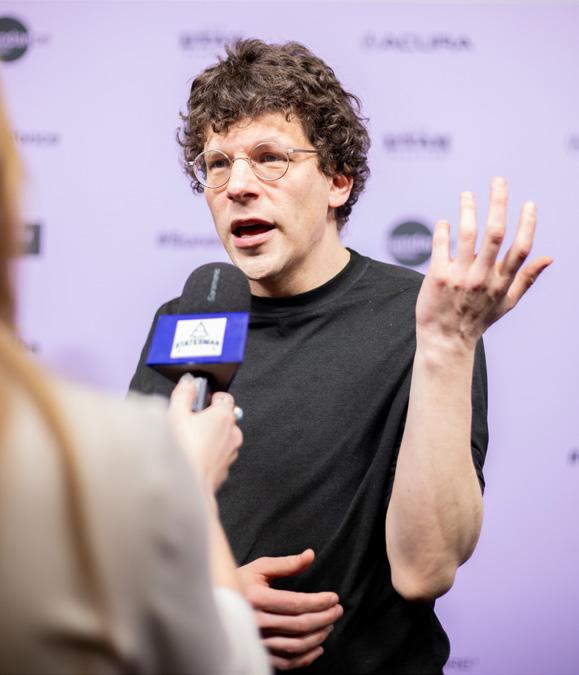
A: “Yes, you know because I’m an actor, which is like kind of a weird, vulnerable job to have in the first place. Because you’re kind of like, beholden to other people liking you and thinking your faces and hideous and all this crazy stuff, you know, so you know, this,
in some ways, because I’m writing, it gives me a guess a little bit more sense that I can be in more control of my own fate, and that I’m not just at the whims of, you know, audiences or other, you know, producers or whatever. So, I guess that’s what I learned about myself. Some are not learned, but to feel like just a little bit of control over my life.”
Q: What brought this film together how did it come to be?

Kneecap director Rich Peppiatt
A: “I went to go and see a gig of an up and coming hip hop out called Kneecap in Belfast. I was just blown away by them and the en-
ergy they brought, and they were just doing something different. I didn’t realize there was a whole subculture in the north of Ireland that was dedicated to living their life through the Irish language. And I thought, if I don’t know about that, and I live here, then there must be millions of people who don’t either and I thought, there’s a film in that. And then we made that film.”
Union directors Brett Story and Stephen Maing
Q: What do you feel like you learned from the people you featured in this film?
A: (Stephen Maing) “Something they said repeatedly was that this is an endurance contest, right. So those

within the movement that could stay there day after day, and stay committed to the cause of supporting and caring for each other and the workers would be the ones that could make this difference, and maybe actually win. So, we take that message, and it really inspired us to stay with them and be embedded on the ground and, and pay close attention to their experience and, and try and close this gap, right between what was seen and unseen, that like, what they were fighting for, was to show that the workers were suffering invisibly, across America, actually. And if we could actually take that message and get that out to the world, that would be something that would be the highest achievement that we could have. So to be here at Sundance and get a chance to share this film is an incredibly meaningful thing.”

Q:What message do you hope this film portrays to the world?
Sugarcane directors
Emily Kassie and Julian Brave Noisecat
A: “Julian Brave NoiseCat: So there were 139 Indian residential schools in Canada, and there were nearly three times as many, 408, Here in the United States. Hundreds of thousands of children were taken away to those schools. This is a foundational story to how North America was colonized, and what happened to Native people. It’s not just our story, it’s all of your story. And we believe that our film can help share that story with the broader world to understand that this is something that we need to know and we need to make right.”
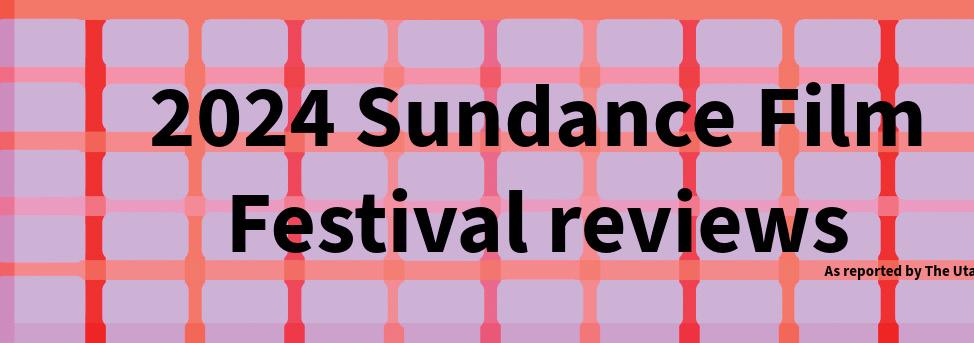
Tendaberry follows the life of Dakota after the love of her life goes home to Ukraine to take care of his sick father — just months before Russia invades the country. With no way of knowing where he is or if he’s alive, Dakota is forced to come to terms with her new reality.
The constant brutality and equally comforting aspects of the city she calls home serve as the backdrop to Dakota’s life as she works, finds new friends, rediscovers old ones and eventually reconnects with her mother and roots. One can only assume the name hails from the song written by Laura Nyro, “New York Tendaberry.” Nyro said, “Tendaberry is my own word, it’s an essence, it’s not death ... it’s birth and it’s very tender, very fragile, very strong, very true. It’s a berry, a tendaberry.”
Depicted through handheld camera work, film and home footage, “Tendaberry” is a beautiful portrait of a young woman rediscovering herself in the underbelly of New York City and learning to come to terms with the inevitable experiences of loss, heartbreak and struggle.
Gary Johnson is a philosophy professor and a bachelor. He teaches boring lectures by day and goes home alone to a boring house at night. His only company are cats, Id and Ego. By happenstance, he discovers his hidden talents as a fake hit man and moonlights as such for the New Orleans police department. While undercover, he meets an unexpected client and ends up in an intricately weaved web he must work his way out of.
With wit and humor, the true story of Gary Johnson is portrayed by Glen Powell as he lives a double life — one plain and simple, another risky, exciting and performative. While undoubtedly hilarious, the film also captures more serious themes of one’s identity, personality and the willingness or ability to change.
Rob Peace is a man at war — with himself.
Hailing from Newark, New Jersey, Peace grew up in a rough area and is the child of an incarcerated man. He is a brilliant academic, and between fostering his passion for molecular biophysics and biochemistry research at boarding school and later on at Yale, he schemes at ways to get his father released from prison. While at college, Peace is at the forefront of marijuana sales for students and accumulates enough money to help his father. Based on the biography by Jeff Hobbs and directed by Chiwetel Ejiofor, “Rob Peace” is a heart-wrenching depiction of being at odds with who you’re expected to be, who you want to be and the balance between the two.
directed by Megan Park, answers the age-old question of “If would you give them?” As Elliott goes forward preparing to older self, she learns alot, and the audience is faced with alot
Seeing Elliott work to build her relationships with her family first time and relive all the feelings, including joy and pain, and the audience along with her, learns that it’s OK to be young happy living in the moment. Though I had to endure some I was also filled with nostalgia and wistfulness. I enjoyed my captured what it looks like to be a young girl emerging into again.
What if another insurrection similar to Jan. 6, 2021 happened? Guard as part of the insurgents? These are the questions “War by the organization Vet Voice. The simulation included high trations playing the roles of the president and others who would those officials sat around the table discussing their next moves, gents and working against the U.S. government. Time is of and the anxiety throughout the film ensues as the problem The stakes rise as time passes, and the question of whether the whole film.
Watching the movie, I felt great frustration because I felt like than the government officials. This made it seem as though movie does a great job of capturing the severity of the issue. of our country and had me seriously considering the threat
Chris Smalls and a group of other workers at an Amazon to create their own union are the subjects of the documentary Jury Award for the Art of Change.

The preview provided on festival. sundance.org reads, “Detailing Peace’s dual rise within the ranks of Yale and the Newark drug trade, Rob Peace explores the double bind between being true to one’s dreams and faithful to one’s roots, exposing the contradictions in the American dream for young Black men.”
To celebrate her 18th birthday, Elliott Labrant goes on a mushroom-induced “trip” with her two best friends. During her hallucination, she is visited by her older self, who gives her a few pieces of advice, one of which is to avoid one person and more specifically, to not fall in love with them. “My Old Ass,” written and “If you could visit your younger self, what piece of advice to leave for college and trying to follow the guidance of her alot of emotions.
family caused me to look back at when I left home for the pain, that went along with that. Throughout the film, Elliott, young and dumb and make mistakes, as long as you’re secondhand embarrassment from some of Elliott’s actions, my fair share of laughs as well. For me, this film perfectly into adulthood. I left the theater eager to watch it all over
The film, directed by Brett Story and Stephen Maing, shows the ups and downs throughout the group’s efforts to create the Amazon Labor Union, independent of any help or support from national organizations. It also shows the effort made by Amazon to stop the group. The union was officially created in 2022, despite pushback from the company. The film shows raw, unfiltered and unpolished moments of the group and their efforts, including moments filmed by workers on their phones. The phone videos are used to show what was happening inside the distribution center and what the company was doing to fight against the union.
A constant theme throughout the whole film is the perseverance of those fighting for this union everyday for months on end. The movie shared a message of hope — a hope that the underdog can win. When seeing this ragtag group of individuals stand up against a huge corporation such as Amazon and see success against all odds, one cannot help but feel inspired. The rawness of the film is amplified by the fact that it doesn’t just show the successes but many of the group’s failures as well.
In a world where cowboy meets thriller, “Ponyboi” is the best of all things queer and crime. This piece of cinema follows a young intersex sex worker called Ponyboi from the hovels of New Jersey who finds himself caught in the middle of love, drugs and a mob. We meet Angel, who is Ponyboi’s work bestie, and Vinny, Angel’s baby daddy, drug dealer and prostitution business owner. Ponyboi also has a chance encounter with an older gentleman, who to me symbolizes his rough past with his country father. The gentleman ends up tipping his hat to Ponyboi and disappearing into the clouds. This signifies Ponyboi leaving behind his messy past life and working on mending his future. Each of these people presents new paths and challenges for Ponyboi to face and ultimately overcome to help heal his inner child.
This film encompassed the internal battle that intersex people might have when faced with the world telling them to choose and pick a side. It has sprinkles of crime, passion and family added into the mix to make this film powerful but also entertaining. “Ponyboi” is sure to give you whiplash, with the changing themes and unexpected emotions, but in the best ways possible.
The Mother of All Lies
happened? What if it escalated with members of the National “War Game” answers. The movie follows a simulation put on high ranking officials from the last five presidential adminiswould be in the situation room in a scenario like this. As moves, there was also a “red cell unit” acting as the insurthe essence as those around the table only have six hours, gets worse and there doesn’t seem to be a clear answer. the president will enact the Insurrection Act looms over
like the focus was more on what the insurgents were doing though the government wasn’t really doing anything. Still, the issue. This unscripted movie gets one thinking about the state of civil war in the U.S.
distribution center in Staten Island who worked together documentary “Union.” It won the festival’s U.S. Documentary Special
Set in Casablanca, “The Mother of All Lies” is a film inside a film meant to show just how important photographs can be not for just you, but many generations to follow. This movie is filmed almost as a video diary for Asmae ElMoudir, the granddaughter of Zahra, who doesn’t allow photographs to be taken of her or anyone else in the family. Confused and wanting answers, ElMoudir sets out to find the truth behind this strange rule by making replica dolls and cardboard houses to represent their street in Morocco. Due to a riot that occurred in 1981, ElMoudir suspects it has something to do with her grandmother’s resentment towards savoring memories through photos. Throughout the film, we see this paper town slowly take shape, while all of Zahra’s family peels away the thick layers of guilt and sorrow that built up over the years. This cinematic story gets the audience thinking back on their own personal voyage and how our memories are as precious as gold.



Heidi, Leah and Caitlin risked their lives driving a behemoth of a suburban to Park City to cover the 2024 Sundance Film Festival. They spent the weekend standing in lines in the hopes of seeing movies that more often than not they were not able to see. Dylan O’Brien was not spotted by the reporters, but it was all made worth it when Jesse Eisenberg graced them with his sweet, sweet presence.
By Lacey Cintron LIFESTYLES REPORTER
The promise of a warm meal and live entertainment filled the halls of the TSC with people eager to enter the Black Student Union’s annual Soul Food Night on Feb. 2, kicking off this year’s Black History month.
The BSU hosts a variety of events — such as movie nights, art showcases and lecture series — to celebrate Black History month, with Soul Food being the biggest. This year’s event completely sold out all 300 seats.
Alexis Brown, a third-year student majoring in animal and dairy sciences, is the BSU treasurer.
“I love being a part of BSU,” Brown said. “We have so much going on throughout the year so Soul Food is definitely the hardest thing to do.”
Brown felt inspired to join after attending a BSU event. “I had gone to one of BSU’s events about celebrating your curly hair,” Brown said. “I thought that this was actually really cool. And from there, I decided I wanted to be a part of that.”
The event has left a lasting impact on many of its attendees.
“My favorite experience has been finishing Soul Food,” Brown said. “It’s my favorite because we put so much work into Soul Food and it’s great to see it all come together.”
Jasmine Kemp, a third-year student majoring in international studies, is the president of BSU.
The primary purpose of BSU, according to their mission statement, is to gain a deeper understanding of all cultures and “promote a higher level of Black consciousness.”
“My favorite experiences have been doing these different events with BSU,” Kemp said. “We got to go to Salt Lake for conferences, and we also went to New Orleans for a conference. It’s a whole bunch of fun stuff.”
Isaiah Jones, the senior director for the Division of Diversity, Equity and Inclusion, took on his position in January 2023 and has been at USU since 2009, completing both his undergraduate and graduate degrees.
Jones said Soul Food is important in facilitating inclusive excellence.
“Soul Food is meant to enhance belonging for all of our students while focusing on the African American experience,” Jones said. “We’re hoping people walk away with more of an understanding of the contributions of African American culture to where we are now.”
The event sets the stage for the six other major events put on by BSU during Black History month. These events explore Black music, artistry and the long-standing ramifications of slavery in America.
BSU will be screening the social critique film “I Am Not Your Negro,” on Feb. 15, an adaption of James Baldwin’s unfinished manuscript “Remember this House.” According to pbs.org, the film seeks to connect “the past of the Civil Rights movement to the present of #BlackLivesMatter.”
On Feb. 22, professor of history Kyle Bulthuis will present on slavery’s legacy and on learning from the nation’s past.
Jones said the Celebration of Black Artistry event on Feb. 17 is a collaboration between the Nora Eccles Harrison Art Museum, flute professor Jeiran Hasan and pianist Amy Glenn to showcase Black composers and Black art.
“I love the arts,” Jones said. “I would definitely point folks to the art event for Caine College of the Arts, the Celebration of Black Artistry.”
The Business, Race and Society Forum on Feb. 9 is hosted by Doug Fiefa, Shontinese Huey, Oscar Marquina and Trudy Reese.
“If people have space and time I recommend the Business, Race and Society Forum,” Jones said. “It’s a very unique perspective, and it’s central to American culture and business. It’s about understanding how global corporations and business leaders think about these issues.”
Since 2009, Jones has witnessed the hard work of students, faculty and staff to create a culture of inclusion.
“The work put into becoming more inclusive is not new,” Jones said. “What I’ve seen over the years is pulling it all together. It’s all happening at the same time in a very

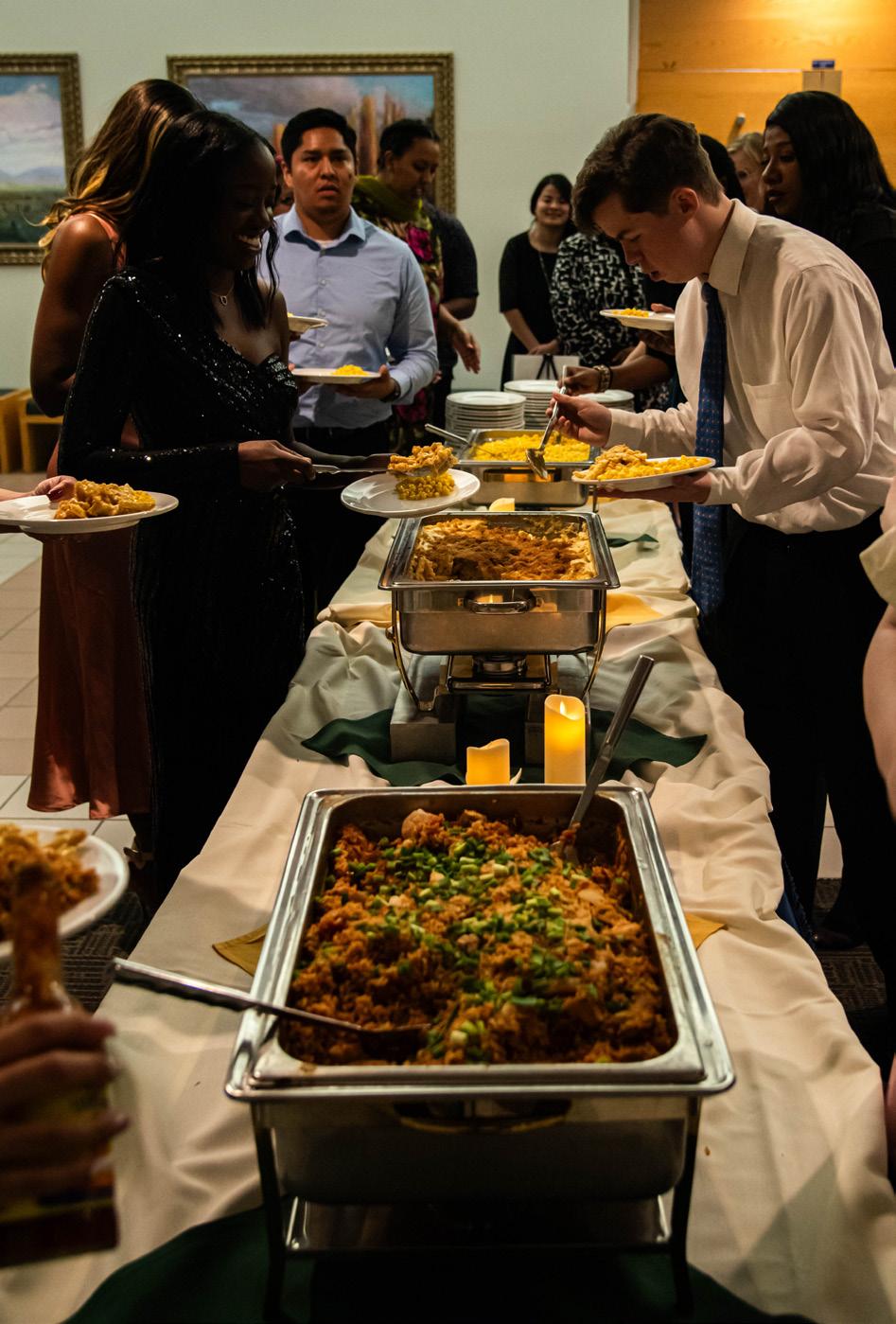
intentional way in order to have the broadest impact and bring more people into the conversation.”
Jones said celebrating Black History month as a community is important because Black history is a reflection of American history.
“Black History month reminds us that Black history is also the history of the United States,” Jones said. “We really can’t tell the story of the U.S., or even USU, without knowing Black history.”
African American influence is found in nearly every aspect of American culture, literature and art according to the article “The Influence of Africans on American Culture,” published by the American Academy of Political and Social Sciences. American music, especially, originates in Black artists and communities.
Read the rest of this story at usustatesman.com

Lacey Cintron is majoring in psychology. She loves learning about the human mind, sharing stories and naps.
— a02388032@usu.edu
By Essence Barnes LIFESTYLES REPORTER
Michelle Rossi is an applied media assistant professor at Utah State University, with 17 years of work within the journalism and PR industries under her belt. Her most recent research has been within the field of environmentalism and media — specifically, animal rights and their representation in the media and her research keyed a unique term: “non-human marginalized groups,” or, animals.
“The question is, what’s the point about having news coverage on human beings and not having animals in the conversation?” Rossi said.
Rossi’s research specializes in the news coverage of farmed animals. She said if there was a “hierarchy of living beings,” farm animals would be on the bottom.
“How does journalism engage with those beings, given that they are at the bottom of the hierarchy?” Rossi said. Rossi explored a specific instance of how journalism typically engages with non-human marginalized groups in her latest research paper. For this paper, she chose to analyze coverage of animals during the 2020 meatpacking crisis. When meatpacking plants had to shut down in 2019 due to the coronavirus, many farmers had to kill and dispose of their animals themselves, often by methods of shooting and gassing.
“Media was not even touching on what was going on in terms of animals and animal suffering,” Rossi said. According to her paper, “Provoking Gut-Level Reactions: A Study on Journalistic Framing During the 2020 Meatpacking Crisis,” journalists were somehow not reporting on the treatment of the farmed animals during this time. They instead relied on indirect accounts of the situation from human voices.
“We didn’t have an accurate picture of what was going on,” Rossi said.
This phenomenon Rossi observed gave rise to her perspective.
“My point was, we need to understand animals as news sources as well,” Rossi said.
Journalists almost always rely on humans as news sources. But Rossi believes animals can be considered as such too.
Rossi said there are many ways in which humans can interact with animals as sources, without relying on verbal communication. People use facial expressions and body movements and sounds; emotions like pain and suffering could be identified through strained cries or eye movements.
“Why not observe the animals themselves?” Rossi said. “Why constrain communication between reporters and sources just because of this written language that we have?”
According to Rossi, she has heard accounts of the animals from farmers or advocacy groups, but still she had

the same question. Why not just go get the story from the animals themselves?
Rossi said she is aware this kind of idea requires the testing and questioning of journalistic standards, such as objectivity and accuracy; she believes this is a positive thing.
“I think that this could be a paradigm shift in news production so you can ensure more accuracy to the process,” Rossi said.
In her dissertation, Rossi furthers her argument and explains why the scope of marginalization should be broadened to include these animals.
“What I tried to do with my interviews and analysis was to understand how journalists dealt with the fact that animals can also be understood as a marginalized group,” Rossi said.
Kai Beattie is a senior majoring in journalism and a stu-
dent of Rossi’s. A majority of his studies have revolved around representation in journalism, and he argues why he believes the representation of marginalized groups in media is so important.
“Well I believe that media is fundamentally a form of communication and acts to both reflect and influence society,” Beattie wrote in an email to The Utah Statesman.
“So when media reflects an angle of society that excludes marginalized groups or reduces them merely to the marginal aspects of their identity, it conveys a feeling that those people similarly should be excluded from society at large.”
Rossi found most journalists, when asked to define what a marginalized group is, said they are groups of human beings.
“If you see animals as part of marginalized groups, what happens?” Rossi said. “You’re going to start reviewing your procedures on how you can cover animals.”
Rossi said this is important because it helps people better understand news coverage of marginalized groups as a whole.
Rossi compares it to the era of change the world was experiencing in 2020. It was a time of figuring out how to address certain highlighted issues of the time, such as gender and race. Many businesses and news organizations were rethinking how to more accurately and truthfully represent marginalized groups.
“If we don’t see animals as part of a marginalized group, how can we review our procedures in terms of news coverage on animals?” Rossi said.
Rossi said understanding animals as marginalized groups is important to having equal and honest representation in the media, for all marginalized groups.

Essence Barnes is a first-year student who can’t come to terms with deciding a major. While that thought looms in the back of her head, she enjoys reading, writing and spending money she doesn’t have on coffee. — a02413313@aggies.usu.edu
By Brian Kirk SPORTS REPORTER
With all the excitement around the success of the Utah State University basketball team, it seems like the perfect time to also remember the program’s biggest figure. It was announced Dec. 13, 2023 that the Dee Glen Smith Spectrum will be permanently honoring former head coach Stew Morrill by naming the court after him.
The presentation took place on Saturday, Feb. 10, during the game against Boise State University.
“Thanks to Utah State University and all the donors who made this happen,” Morrill wrote in response to the announcement. “When I received the call, I was a little bit overwhelmed and emotional. Whenever your efforts are recognized in a manner like this, it is special. Of course, none of the success we had would have been possible without all the players and assistant coaches.”
Boasting a 402-156 overall record at Utah State over 17 seasons made Morrill the all-time most victorious coach in the history of the basketball program. Through Morrill’s leadership, Utah State won the regular season championship seven times, the conference championship six times and competed in the NCAA tournament eight times.
“He’s not just the best coach at Utah State,” current Utah State head coach
Danny Sprinkle said in a post-game interview. “He’s one of the best coaches in Division I history.”
For Utah State, the record books have already been rewritten this season as the Aggies had their best start to a season under a first-year Aggie head coach in program history. It continues to be history in the making as Sprinkle just earned his one hundredth

career win after the Aggies beat the San Jose State University Spartans 82-61. And while one hundred wins is an incredible achievement. Sprinkle understands the legacy he is part of here at Utah State and that the goal is much higher.
“Every day I walk into that office, and I see it — Stew Morrill,” Sprinkle said. “Suddenly 100 wins is not very much. I have a lot of work to do.”
Sprinkle continued his praise of Morrill as he likened Morrill’s impact on college basketball to the same level as storied coaches such as Mike Krzyzewski at Duke University or Jim Boeheim at Syracuse.
“It’s a tremendous honor to be coaching here knowing that he coached before me,” Sprinkle added. Morrill was humble and flattered by the kind words spoken by Sprinkle.
“I appreciate the kindness,” Morrill said. “Danny is a nice guy.” Utah State wasn’t the former coach’s only stop. In fact, Morrill began his collegiate coaching career as an assistant coach for Gonzaga University under Adrian Buoncristiani.
“That led me to my first coaching job as an assistant coach where I helped out for four seasons before they fired all of us,” Morrill said, laughing.
Opportunity kept presenting itself to Morrill. He applied for the job to be Gonzaga’s new head coach but was not hired. He instead took another assistant position at the University of Montana where he learned from
head coach Mike Montgomery.
“That was the best move I probably ever made,”
Morrill said. “Mike was my mentor — I owe a lot to that time as an assistant, I learned a lot.”
It was not enough to be the assistant coach, though; Morrill believed he was capable of more. He wanted his own team. The former coach added that coaching is a great profession filled with high stress. And he wanted to make his mark.
“Being a good assistant only makes you a good assistant,” Morrill said. “If you survive the rigors of the profession, you will be successful.”
Morrill finally got his chance, becoming the head coach of the Grizzlies after Montgomery took a head coach job at Stanford University.
Morrill was with the Grizzlies as head coach for five seasons and had a record of 97 wins and 52 losses. In the 1990-91 season, Morrill led Montana to a Big Sky Conference championship, which gave them their second ever berth into the NCAA tournament.
Morrill said he enjoyed his time and loved his team, and his time at Montana was worth it as it led him to meet his wife, Vicki.
His next stop was at Colorado State University where he coached for seven seasons and held a record of

121-86. Though the Buffaloes did not win any silverware while Morrill was there, it is now the place he calls home.
But it was at Utah State where Morrill became a household name among the Aggie nation, and where he would cement his legacy.
Morrill is synonymous with many amazing moments in Utah State basketball’s history. Moments like 2007’s “Spectrum Magic” shot, when Stephen DuCharme hit a crucial 3-pointer deep in overtime to help lift the Aggies to victory over the Nevada Wolfpack, who were ranked ninth in the nation at the time.
Or the famous comeback against Boise State where the Aggies scored nine points with just barely over one minute left to play to steal the win from the Broncos.
Morrill’s most successful run however was between the 2007-08 season and the 2010-11
season, where Morrill led his team to four straight WAC regular season titles and the chance to compete in the NCAA tournament each of those seasons. And to put an exclamation point on it, Morrill also received the WAC coach of the year award in 2009, 10 and 11.
But for Morrill, the legacy of success was not the highlight of his career. It was just the results of hard work and consistency day in and day out on the court.
“Winning was nice, but it was not the most important part of my job,” Morrill said. “The relationships I built with all of the players and staff is what I enjoyed the most. It will be nice to reconnect with players and coaches that I worked with.”
Morrill said he is excited to come back and take the court one more time. He still feels overwhelmed by the naming of the court in his honor and does not feel that he is deserving of such an honor. But with the Spectrum packed with fans chanting his name, and the lights reflecting off the court, he may just change his tune.


Brian Kirk is a human sophomore studying journalism. When he is definitely not abducting cows, he enjoys sports, board games and Godzilla movies.
brian.kirk@usu.edu
By Avery Truman LIFESTYLES REPORTER
Utah State University’s Eastern Theatre Department is ready for lights, camera and action with several opportunities for students to get involved in stage management, acting, sound design and more. Each year, the department puts together four shows of varying genres.
Kassidy Childs, a student actor in the department, decided to join the team after her positive experience with theater in high school.
“I’ve met some of the most amazing people through theater,” Childs wrote in an email to The Utah Statesman. “When you spend every day with a group of people, they really grow on you.”
Childs said she is excited for “Something Rotten,” a musical that will open on Feb. 29 at the Geary Theatre. The story takes place in London in 1595 and follows two brothers trying to make it in the playwriting world against the famous William Shakespeare.
The department offers small class sizes to tailor to individual student needs.
“Smaller classes are good for getting more individual work time,” Childs wrote. “In bigger classes, you can learn from each other and collaborate a lot more.”
Camden Chamberlain, an actor in “Something Rotten,” has experience in stage lighting and has worked as a stage technician.
Chamberlain said there are several benefits to joining the department.
“Just being more involved with the program and getting to become closer with my fellow actors and techies,” Chamberlain wrote in an email to the Statesman. “[It] also gives you something to be looking forward to with all the activities that are planned!”
Brent Innes, who has his BFA in lighting design and MFA in technical production from USU, is very involved in the department.
“I literally wear all the hats,” Innes wrote in an email to the Statesman. “I do all things production – Producer, Technical Director, Set Designer, Lighting Designer, Props Designer, Sound Designer, Stage Manager mentor, Build Scenery, mentor tech and design students, recruit new students and the list goes on.”
Innes said he loves his position teaching the new generation of theatre students and professionals.
“In the few years I worked out of theatre production doing other various jobs and attempts at a career I would always find myself coming back to theatre,” Innes wrote. “I love the creative collaborative work environment, I love that it is a constantly evolving world, and it is ever shaping our experiences.”
According to Innes, though a show may have the same lines and music, no two performances are ever identical. “Theatre is never doing the same thing the same way,” Innes wrote. “I have done several productions that have been repeats but with different groups in different spac-

PHOTO USU Eastern Theatre Department students perform in a play.
es, and while the music and script may be the same, the show itself is always a different experience.”
According to Innes, students benefit from the smaller class sizes because they get more personalized help and the instructors have more time to work with each student’s existing talent.
“We do have some bigger broadcast classes that go out statewide as well, such as Introduction to Film and Introduction to Theatre,” Innes wrote.
According to Innes, the department hosts sleepovers where students bring mattresses and hammocks to spend the night on the tension grid system above the black box theatre.
“They have regular game nights and other activities where the snacks and laughs are plentiful,” Innes wrote.
Innes said even students who are not majoring in the arts also enjoy participating in the department and find a home within the theatre. He referenced Pablo Picasso, who once said theatre is the greatest of all art forms because it allows humans to connect with each other.
“[We] create experiences on stage that mimic what we see in life and express what often cannot be said,” Innes wrote.
According to Innes, the department has many memories and adventures to last a lifetime, including a trip to
Alberta, Canada, where the group performed nine shows over 11 days. They traveled a total of 2,500 miles.
“The experience created a lifetime of memories for us as a program and as individuals,” Innes wrote. “This is what we do at Eastern Theatre – we create opportunities for incredible experiences.”
*Cameron Carnes contributed to this article.

Avery Truman is pursuing environmental studies and geography. She is obsessive about astronomy, writing and reading science fiction and being the lifestyles editor for The Utah Statesman.
Editor’s note:
In the first installment of Aggie Blue Books, the Statesman’s weekly book review, a member of the editorial board will write a commentary on a book that is of significance to them.The hope is to open up the section for submissions from the campus community to allow a space for open discourse on literature and its intersection with culture.
From the complex mind of American musician and poet Patti Smith comes “Just Kids” — a raw and inevitably honest account of the human experience.
It’s a memoir highlighting lives lived to the fullest and people who wanted desperately to make it. The book begins, in the very first sentence, with the death of Robert Mapplethorpe, who became Smith’s muse and closest confidant. To Patti, Mapplethorpe was art — an all encapsulated piece personified. Following the foreword, the book is written chronologically and takes the reader through the youth of Smith and her arrival and introduction to the underbelly of the 1970s art scene in New York City.
She paints an enigmatic picture: one of art and music and sex and poverty and exploration exploding in Brooklyn in the 60s and 70s. This is an ode to Smith and Mapplethorpe’s formative years as creators and thinkers, painters and photographers, as writers and lovers.
“The light poured through the windows upon his photographs and the poem of us sitting together a last time. Robert dying: creating silence. Myself, destined to live, listening closely, destined closely to a silence that would take a lifetime to express.”
Before she established herself as the “mother of punk” with the release of her debut album Horses, in 1975, Smith was young and in love with poets such as Arthur Rimbaud, Charles Baudelaire and Bob Dylan. Born in 1946 and hailing from the north side of Chicago, she realized she wasn’t meant to be a waitress like her mother and on July 3, 1967 hopped a bus to Brooklyn, New York.
Upon arrival in New York City in 1967, Smith was in possession of nothing but stolen money from a later-returned purse and an address. The address leads her to a brownstone and a sleeping boy whom she describes looking like a “hippie shepherd” — Robert Mapplethorpe.
“It was the summer Coltrane died. The summer of “Crystal Ship”. Flower children raised their empty arms and China exploded the H-bomb. Jimi Hendrix set his guitar in flames in Monetery. AM radio played “Ode to Billie Joe.”
There were riots in Newark, Milwaukee, and Detroit. It was the summer of Elvira Madigan, the summer of love. And in this shifting, inhospitable atmosphere, a chance encounter changed the course of my life. It was the summer
They were young and figuring it out with the backdrop of the Brooklyn skyline behind them.
“There were days, rainy gray days, when the streets of Brooklyn were worthy of a photograph, every window the lens of a Leica, the view grainy and immobile. We gathered our colored pencils and sheets of paper and drew like wild, feral children into the night, until, exhausted, we fell into bed. We lay in each other’s arms, still awkward but happy, exchanging breathless kisses into sleep.”
Smith writes not to chronicle the success they both found, but the moments right before they turned that corner. She writes on moments of naivete, innocence and the hope that accompanies potential.
There were days, rainy gray days, when the streets of Brooklyn were worthy of a photograph, every window the lens of a Leica, the view grainy and immobile.
I met Robert Mapplethorpe.”
Mapplethorpe was ambitious. He was an artist himself and they immediately formed a bond tied through obsession with their crafts. The oxymoron of Smith’s simple yet achingly intricate prose tells the tale of two desperately poor artists who had a record player, their work and each other.
The reverence with which Smith writes of her ever-evolving relationship with Mapplethorpe speaks to the awe and respect she held for him. “Robert and I kept our vow. Neither would leave the other. I never saw him through the lens of sexuality. My picture of him remained intact. He was the artist of my life.”
Smith’s uncanny ability to plant the reader right in the middle of the room makes it seem as though we sat in room 204 at the Chelsea Hotel, drank bad coffee at Max’s Kansas City, stood behind the camera lens with Robert and witnessed every stroke of genius as Patti wrote feverishly, surrounded by discarded paper, the tinny sound of History of Motown on the record player.
— Patti Smith
“One day we were walking toward the fountain, the epicenter of activity, when an older couple stopped and openly observed us. Robert enjoyed being noticed, and he affectionately squeezed my hand. “Oh take their picture,” said the woman to her bemused husband, “I think they’re artists.” “Oh go on,” he said. “They’re just kids.””

Leah Call is a senior studying print journalism. When she is not furiously studying the AP Stylebook, she enjoys listening to the Velvet Underground and reading the wise words of Patti Smith in her beloved blue hammock.
— leah.call@usu.edu

Idiscovered the struggle of a logan winter by trudging to class at 7:30 in -4 degree weather.
Most students have had trouble with Logan’s winter, whether it is slipping in front of the TSC, bordering frostbite in your hands, or almost being run over by a snow plow.
I decided to write this article to serve as a survival guide to all things winter, including seasonal depression, and how to stay warm and cozy without having to pack a parka, and how to have fun in freezing temperatures
The main pillar of winter’s trials is the winter blues, and the more extreme version Seasonal Affective Disorder (SAD). The American Psychiatric Association’s Healthy Minds Monthly poll found that 38% of Americans have overall mood declines in the winter. The culprits of this mood decline are lack of sunlight, shorter days, and the isolation of the winter months. Research found serotonin levels decreased with lack of sunlight, showing serotonin production was directly related to how much sunlight you have. This serotonin is created by sunlight entering your eyes, hitting parts of the retina signaling your brain to produce more serotonin. The mood-boosting effects of sunlight can be replicated by a light therapy box which improves seasonal depression symptoms in 40% to 60% of people. Some countries even have light cafes with bright therapy lights to help relax and boost customers’ moods during the winter!
Another way you can get up your serotonin levels during seasonal depression is exercise, this is due to the amino acid named Tryptophan. Studies linked exercising to an increase in Tryptophan, creating a natural increase in serotonin with similar effects as an antidepressant. Exercises you can do during the winter are treadmill running, brisk walking, or my favorite yoga.
The easiest way you can help tackle seasonal depression is positive mood induction. This technique involves altering your current mood state through manipulation with positive experiences. To get over the winter blues you can watch feel-good shows and movies, smile while walking, or listen to positive music. Some music I find it impossible to be sad while listening to is bossa nova and oldies. If you want a serotonin boost, you have to turn off the sad playlist and start absorbing yourself in positive experiences.
Now to the cold weather, the nail in the coffin for most USU students. To stay warm it’s critical to have thermals, the typical rule of thumb is to wear thermals when it reaches under 30 Fahrenheit. If you are the type of person who hates having to carry around a heavy coat, try a combo of thermals, a sweater, and a light coat. If you wanna stay stylish while not freezing, a fan favorite is the sweater collar combo. Keep in mind while looking for sweaters, most cold sweaters are made of wool (which i learned the hard way when all my sweaters shrunk 3 sizes in the wash).
It’s important to pay attention to keeping yourself warm including your ears. Ears are specifically sensitive to the cold because they don’t have the same thickness of skin that our body has. Headphones can help keep your ears protected if their battery can survive the cold, better solutions are ear muffs or trapper hats.
The critical component to surviving winter is good shoes. I underestimated the importance of winter boots until I slipped on thick ice in my tennis shoes. The good balance with winter boots is spiky soles, ankle support, and a warm interior. Typically hiking boots can work well, just make sure you are waterproofing your shoes to keep them looking nice.
Winter can feel boring and at times lonely. A survey hosted by OnePoll found 39 percent of Americans feel “bored” during winter. Although at times all you can do is stay inside your room, some solutions to winter boredom can help make things interesting. If you are more on the thrill-seeking side there is always skiing. Ski resorts Brighton Resort, Nordic Valley, and Beaver Mountain are some of Utah’s cheapest helping curve the steep price of the slopes.
If you are interested in learning something new, I recommend getting into podcasts. Walking in the cold or shoveling snow becomes a lot easier when you have something good to listen to. Some good podcasts are Science VS, Decoder Ring, and Matinence Phase, all of them are well-researched and leave you feeling smarter than before.
The last activity to deal with both winter depression and boredom is baking or cooking. Research finds these activities can increase positive emotions by providing you with achievement and social connection. So if you feel lonely, call over a friend and bake some bread. Winters can be difficult and with Logan’s winter temperatures commonly falling slightly below freezing, its common to be frustrated with the weather. But at least we have the weather to thank for teaching us what a snow squall is.
— ronan.spencer@usu.edu
Letters to the editor can be hand-delivered or mailed to the USU Student Media office in TSC 118. They can also be emailed to editor@usustatesman.com
For more information about Letters to the Editor, visit usustatesman.com/opinionpolicy.
